EDST101: Exploring Learning Theories and Individual Differences Essay
VerifiedAdded on 2022/09/28
|6
|1885
|25
Essay
AI Summary
This essay, written for the EDST101 course, delves into the multifaceted concept of learning, beginning with a definition and exploration of its critical attributes. It examines various factors influencing the learning process, including individual differences attributed to mental capabilities, physical traits, and cultural backgrounds. The essay also addresses learning difficulties, differentiating them from other disabilities and exploring conditions like dyslexia and dyscalculia. Furthermore, it analyzes the impact of linguistic and cultural backgrounds on learning styles and outcomes, emphasizing the influence of socioeconomic status and the quality of education received. The physical environment's role, including classroom design, noise levels, and lighting, is also considered, highlighting its impact on learning efficiency. The essay concludes by comparing learning to information processing and referencing the importance of memory and sleep in the learning process, while also using the metaphor of house building to explain the process of learning.
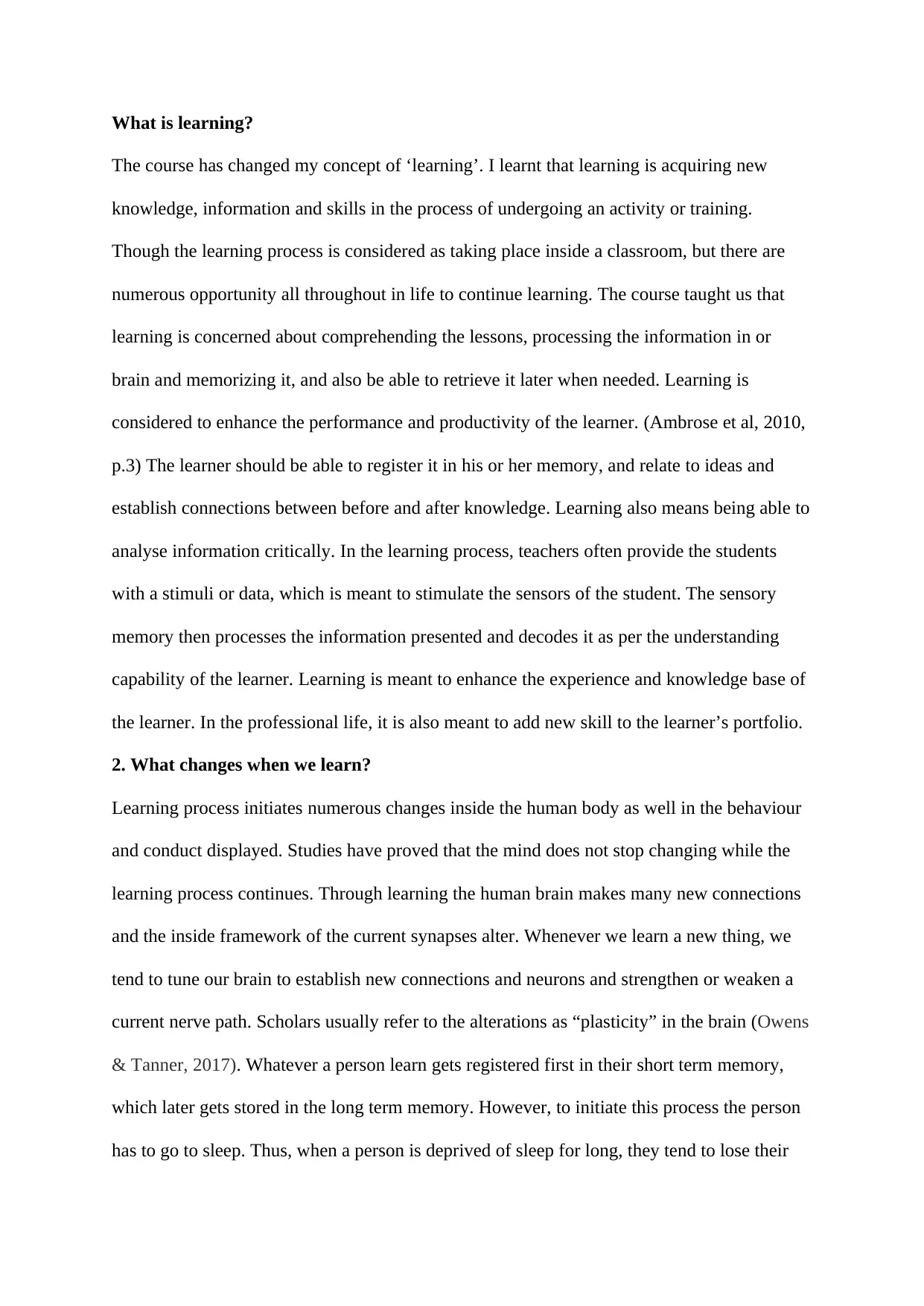
What is learning?
The course has changed my concept of ‘learning’. I learnt that learning is acquiring new
knowledge, information and skills in the process of undergoing an activity or training.
Though the learning process is considered as taking place inside a classroom, but there are
numerous opportunity all throughout in life to continue learning. The course taught us that
learning is concerned about comprehending the lessons, processing the information in or
brain and memorizing it, and also be able to retrieve it later when needed. Learning is
considered to enhance the performance and productivity of the learner. (Ambrose et al, 2010,
p.3) The learner should be able to register it in his or her memory, and relate to ideas and
establish connections between before and after knowledge. Learning also means being able to
analyse information critically. In the learning process, teachers often provide the students
with a stimuli or data, which is meant to stimulate the sensors of the student. The sensory
memory then processes the information presented and decodes it as per the understanding
capability of the learner. Learning is meant to enhance the experience and knowledge base of
the learner. In the professional life, it is also meant to add new skill to the learner’s portfolio.
2. What changes when we learn?
Learning process initiates numerous changes inside the human body as well in the behaviour
and conduct displayed. Studies have proved that the mind does not stop changing while the
learning process continues. Through learning the human brain makes many new connections
and the inside framework of the current synapses alter. Whenever we learn a new thing, we
tend to tune our brain to establish new connections and neurons and strengthen or weaken a
current nerve path. Scholars usually refer to the alterations as “plasticity” in the brain (Owens
& Tanner, 2017). Whatever a person learn gets registered first in their short term memory,
which later gets stored in the long term memory. However, to initiate this process the person
has to go to sleep. Thus, when a person is deprived of sleep for long, they tend to lose their
The course has changed my concept of ‘learning’. I learnt that learning is acquiring new
knowledge, information and skills in the process of undergoing an activity or training.
Though the learning process is considered as taking place inside a classroom, but there are
numerous opportunity all throughout in life to continue learning. The course taught us that
learning is concerned about comprehending the lessons, processing the information in or
brain and memorizing it, and also be able to retrieve it later when needed. Learning is
considered to enhance the performance and productivity of the learner. (Ambrose et al, 2010,
p.3) The learner should be able to register it in his or her memory, and relate to ideas and
establish connections between before and after knowledge. Learning also means being able to
analyse information critically. In the learning process, teachers often provide the students
with a stimuli or data, which is meant to stimulate the sensors of the student. The sensory
memory then processes the information presented and decodes it as per the understanding
capability of the learner. Learning is meant to enhance the experience and knowledge base of
the learner. In the professional life, it is also meant to add new skill to the learner’s portfolio.
2. What changes when we learn?
Learning process initiates numerous changes inside the human body as well in the behaviour
and conduct displayed. Studies have proved that the mind does not stop changing while the
learning process continues. Through learning the human brain makes many new connections
and the inside framework of the current synapses alter. Whenever we learn a new thing, we
tend to tune our brain to establish new connections and neurons and strengthen or weaken a
current nerve path. Scholars usually refer to the alterations as “plasticity” in the brain (Owens
& Tanner, 2017). Whatever a person learn gets registered first in their short term memory,
which later gets stored in the long term memory. However, to initiate this process the person
has to go to sleep. Thus, when a person is deprived of sleep for long, they tend to lose their
Paraphrase This Document
Need a fresh take? Get an instant paraphrase of this document with our AI Paraphraser
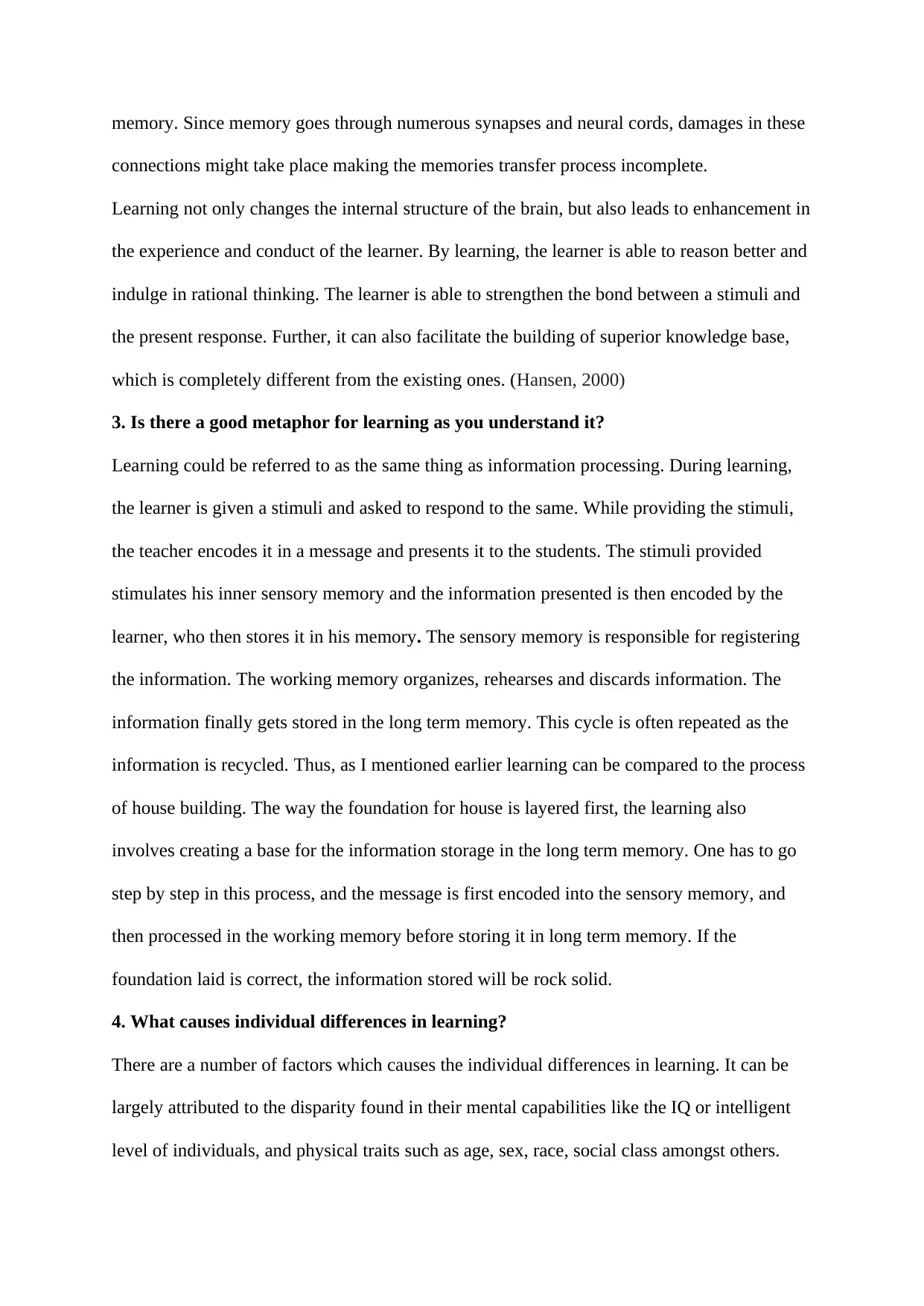
memory. Since memory goes through numerous synapses and neural cords, damages in these
connections might take place making the memories transfer process incomplete.
Learning not only changes the internal structure of the brain, but also leads to enhancement in
the experience and conduct of the learner. By learning, the learner is able to reason better and
indulge in rational thinking. The learner is able to strengthen the bond between a stimuli and
the present response. Further, it can also facilitate the building of superior knowledge base,
which is completely different from the existing ones. (Hansen, 2000)
3. Is there a good metaphor for learning as you understand it?
Learning could be referred to as the same thing as information processing. During learning,
the learner is given a stimuli and asked to respond to the same. While providing the stimuli,
the teacher encodes it in a message and presents it to the students. The stimuli provided
stimulates his inner sensory memory and the information presented is then encoded by the
learner, who then stores it in his memory. The sensory memory is responsible for registering
the information. The working memory organizes, rehearses and discards information. The
information finally gets stored in the long term memory. This cycle is often repeated as the
information is recycled. Thus, as I mentioned earlier learning can be compared to the process
of house building. The way the foundation for house is layered first, the learning also
involves creating a base for the information storage in the long term memory. One has to go
step by step in this process, and the message is first encoded into the sensory memory, and
then processed in the working memory before storing it in long term memory. If the
foundation laid is correct, the information stored will be rock solid.
4. What causes individual differences in learning?
There are a number of factors which causes the individual differences in learning. It can be
largely attributed to the disparity found in their mental capabilities like the IQ or intelligent
level of individuals, and physical traits such as age, sex, race, social class amongst others.
connections might take place making the memories transfer process incomplete.
Learning not only changes the internal structure of the brain, but also leads to enhancement in
the experience and conduct of the learner. By learning, the learner is able to reason better and
indulge in rational thinking. The learner is able to strengthen the bond between a stimuli and
the present response. Further, it can also facilitate the building of superior knowledge base,
which is completely different from the existing ones. (Hansen, 2000)
3. Is there a good metaphor for learning as you understand it?
Learning could be referred to as the same thing as information processing. During learning,
the learner is given a stimuli and asked to respond to the same. While providing the stimuli,
the teacher encodes it in a message and presents it to the students. The stimuli provided
stimulates his inner sensory memory and the information presented is then encoded by the
learner, who then stores it in his memory. The sensory memory is responsible for registering
the information. The working memory organizes, rehearses and discards information. The
information finally gets stored in the long term memory. This cycle is often repeated as the
information is recycled. Thus, as I mentioned earlier learning can be compared to the process
of house building. The way the foundation for house is layered first, the learning also
involves creating a base for the information storage in the long term memory. One has to go
step by step in this process, and the message is first encoded into the sensory memory, and
then processed in the working memory before storing it in long term memory. If the
foundation laid is correct, the information stored will be rock solid.
4. What causes individual differences in learning?
There are a number of factors which causes the individual differences in learning. It can be
largely attributed to the disparity found in their mental capabilities like the IQ or intelligent
level of individuals, and physical traits such as age, sex, race, social class amongst others.
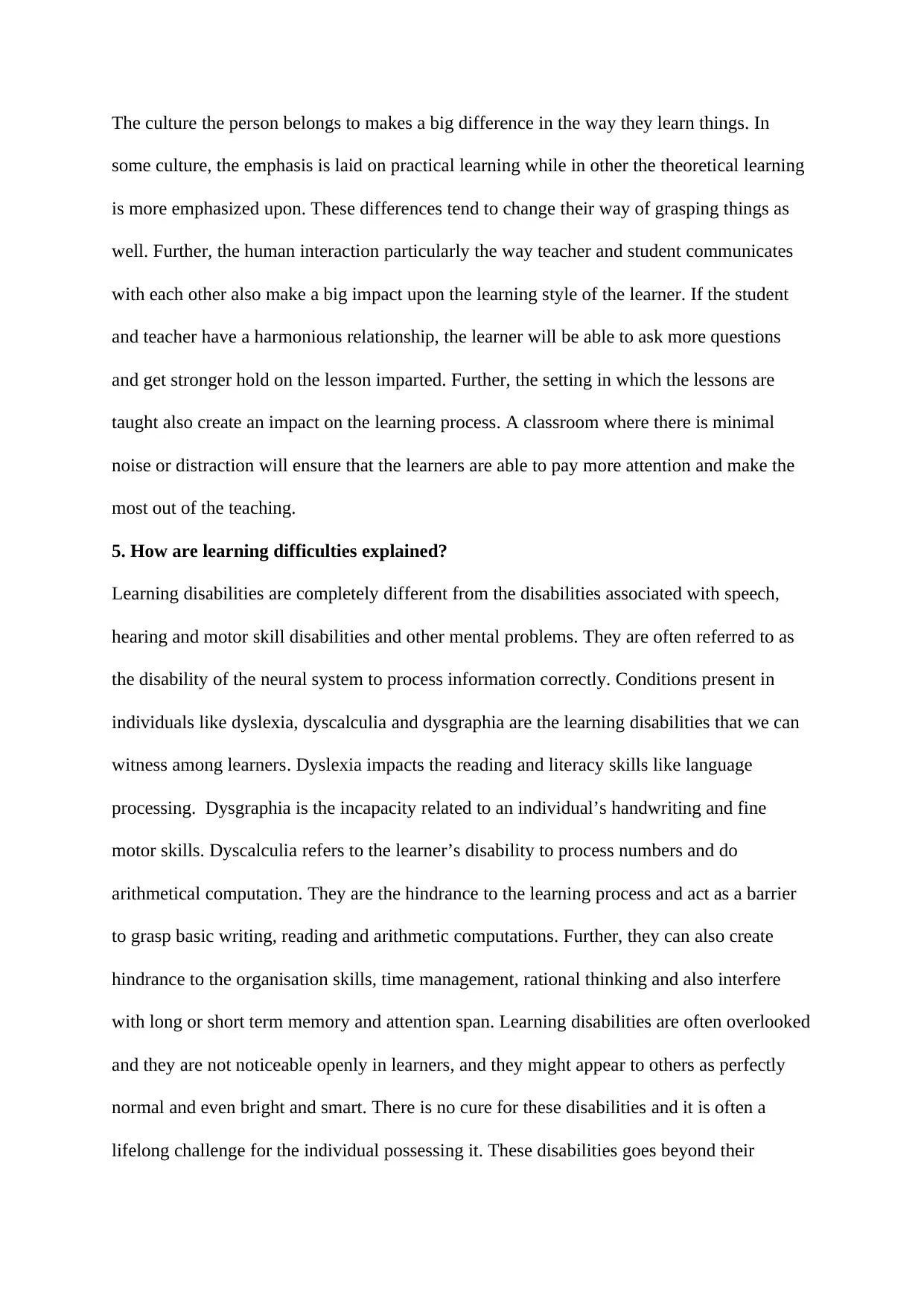
The culture the person belongs to makes a big difference in the way they learn things. In
some culture, the emphasis is laid on practical learning while in other the theoretical learning
is more emphasized upon. These differences tend to change their way of grasping things as
well. Further, the human interaction particularly the way teacher and student communicates
with each other also make a big impact upon the learning style of the learner. If the student
and teacher have a harmonious relationship, the learner will be able to ask more questions
and get stronger hold on the lesson imparted. Further, the setting in which the lessons are
taught also create an impact on the learning process. A classroom where there is minimal
noise or distraction will ensure that the learners are able to pay more attention and make the
most out of the teaching.
5. How are learning difficulties explained?
Learning disabilities are completely different from the disabilities associated with speech,
hearing and motor skill disabilities and other mental problems. They are often referred to as
the disability of the neural system to process information correctly. Conditions present in
individuals like dyslexia, dyscalculia and dysgraphia are the learning disabilities that we can
witness among learners. Dyslexia impacts the reading and literacy skills like language
processing. Dysgraphia is the incapacity related to an individual’s handwriting and fine
motor skills. Dyscalculia refers to the learner’s disability to process numbers and do
arithmetical computation. They are the hindrance to the learning process and act as a barrier
to grasp basic writing, reading and arithmetic computations. Further, they can also create
hindrance to the organisation skills, time management, rational thinking and also interfere
with long or short term memory and attention span. Learning disabilities are often overlooked
and they are not noticeable openly in learners, and they might appear to others as perfectly
normal and even bright and smart. There is no cure for these disabilities and it is often a
lifelong challenge for the individual possessing it. These disabilities goes beyond their
some culture, the emphasis is laid on practical learning while in other the theoretical learning
is more emphasized upon. These differences tend to change their way of grasping things as
well. Further, the human interaction particularly the way teacher and student communicates
with each other also make a big impact upon the learning style of the learner. If the student
and teacher have a harmonious relationship, the learner will be able to ask more questions
and get stronger hold on the lesson imparted. Further, the setting in which the lessons are
taught also create an impact on the learning process. A classroom where there is minimal
noise or distraction will ensure that the learners are able to pay more attention and make the
most out of the teaching.
5. How are learning difficulties explained?
Learning disabilities are completely different from the disabilities associated with speech,
hearing and motor skill disabilities and other mental problems. They are often referred to as
the disability of the neural system to process information correctly. Conditions present in
individuals like dyslexia, dyscalculia and dysgraphia are the learning disabilities that we can
witness among learners. Dyslexia impacts the reading and literacy skills like language
processing. Dysgraphia is the incapacity related to an individual’s handwriting and fine
motor skills. Dyscalculia refers to the learner’s disability to process numbers and do
arithmetical computation. They are the hindrance to the learning process and act as a barrier
to grasp basic writing, reading and arithmetic computations. Further, they can also create
hindrance to the organisation skills, time management, rational thinking and also interfere
with long or short term memory and attention span. Learning disabilities are often overlooked
and they are not noticeable openly in learners, and they might appear to others as perfectly
normal and even bright and smart. There is no cure for these disabilities and it is often a
lifelong challenge for the individual possessing it. These disabilities goes beyond their
⊘ This is a preview!⊘
Do you want full access?
Subscribe today to unlock all pages.

Trusted by 1+ million students worldwide
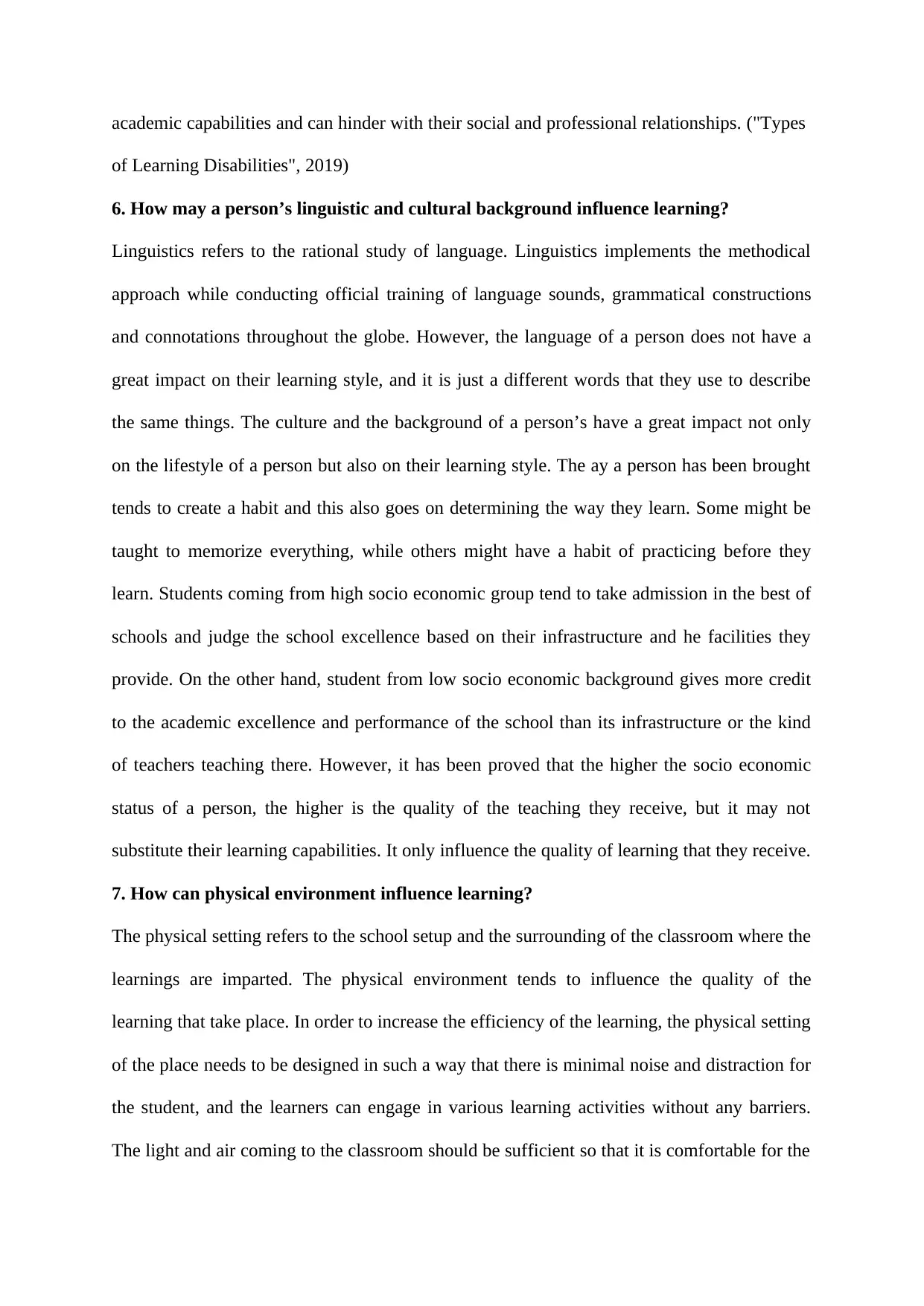
academic capabilities and can hinder with their social and professional relationships. ("Types
of Learning Disabilities", 2019)
6. How may a person’s linguistic and cultural background influence learning?
Linguistics refers to the rational study of language. Linguistics implements the methodical
approach while conducting official training of language sounds, grammatical constructions
and connotations throughout the globe. However, the language of a person does not have a
great impact on their learning style, and it is just a different words that they use to describe
the same things. The culture and the background of a person’s have a great impact not only
on the lifestyle of a person but also on their learning style. The ay a person has been brought
tends to create a habit and this also goes on determining the way they learn. Some might be
taught to memorize everything, while others might have a habit of practicing before they
learn. Students coming from high socio economic group tend to take admission in the best of
schools and judge the school excellence based on their infrastructure and he facilities they
provide. On the other hand, student from low socio economic background gives more credit
to the academic excellence and performance of the school than its infrastructure or the kind
of teachers teaching there. However, it has been proved that the higher the socio economic
status of a person, the higher is the quality of the teaching they receive, but it may not
substitute their learning capabilities. It only influence the quality of learning that they receive.
7. How can physical environment influence learning?
The physical setting refers to the school setup and the surrounding of the classroom where the
learnings are imparted. The physical environment tends to influence the quality of the
learning that take place. In order to increase the efficiency of the learning, the physical setting
of the place needs to be designed in such a way that there is minimal noise and distraction for
the student, and the learners can engage in various learning activities without any barriers.
The light and air coming to the classroom should be sufficient so that it is comfortable for the
of Learning Disabilities", 2019)
6. How may a person’s linguistic and cultural background influence learning?
Linguistics refers to the rational study of language. Linguistics implements the methodical
approach while conducting official training of language sounds, grammatical constructions
and connotations throughout the globe. However, the language of a person does not have a
great impact on their learning style, and it is just a different words that they use to describe
the same things. The culture and the background of a person’s have a great impact not only
on the lifestyle of a person but also on their learning style. The ay a person has been brought
tends to create a habit and this also goes on determining the way they learn. Some might be
taught to memorize everything, while others might have a habit of practicing before they
learn. Students coming from high socio economic group tend to take admission in the best of
schools and judge the school excellence based on their infrastructure and he facilities they
provide. On the other hand, student from low socio economic background gives more credit
to the academic excellence and performance of the school than its infrastructure or the kind
of teachers teaching there. However, it has been proved that the higher the socio economic
status of a person, the higher is the quality of the teaching they receive, but it may not
substitute their learning capabilities. It only influence the quality of learning that they receive.
7. How can physical environment influence learning?
The physical setting refers to the school setup and the surrounding of the classroom where the
learnings are imparted. The physical environment tends to influence the quality of the
learning that take place. In order to increase the efficiency of the learning, the physical setting
of the place needs to be designed in such a way that there is minimal noise and distraction for
the student, and the learners can engage in various learning activities without any barriers.
The light and air coming to the classroom should be sufficient so that it is comfortable for the
Paraphrase This Document
Need a fresh take? Get an instant paraphrase of this document with our AI Paraphraser
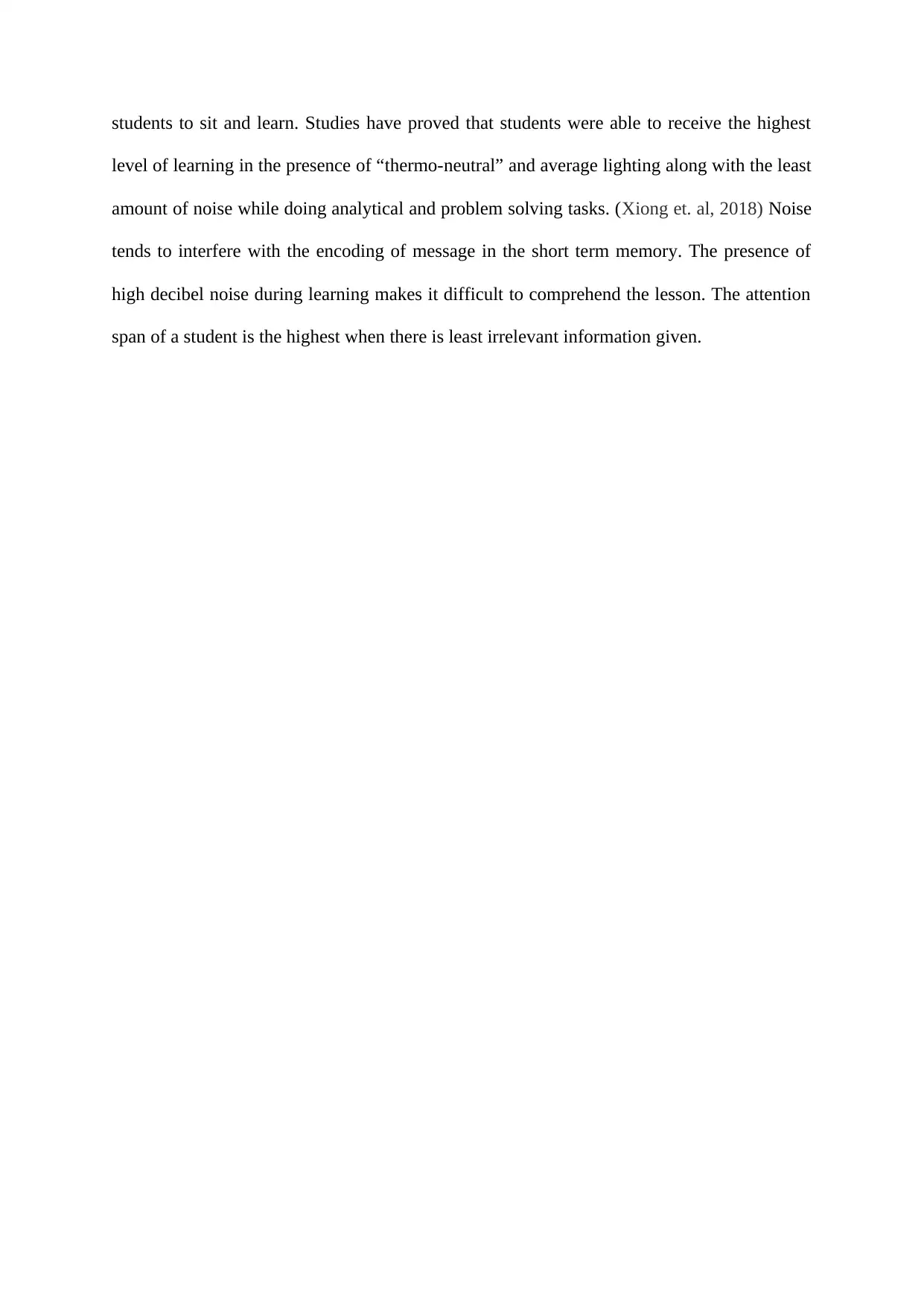
students to sit and learn. Studies have proved that students were able to receive the highest
level of learning in the presence of “thermo-neutral” and average lighting along with the least
amount of noise while doing analytical and problem solving tasks. (Xiong et. al, 2018) Noise
tends to interfere with the encoding of message in the short term memory. The presence of
high decibel noise during learning makes it difficult to comprehend the lesson. The attention
span of a student is the highest when there is least irrelevant information given.
level of learning in the presence of “thermo-neutral” and average lighting along with the least
amount of noise while doing analytical and problem solving tasks. (Xiong et. al, 2018) Noise
tends to interfere with the encoding of message in the short term memory. The presence of
high decibel noise during learning makes it difficult to comprehend the lesson. The attention
span of a student is the highest when there is least irrelevant information given.

References
Ambrose, S. A., Bridges, M. W., DiPietro, M., Lovett, M. C., & Norman, M. K. (2010). How
learning works: Seven research-based principles for smart teaching. John Wiley &
Sons.
Hansen, R. E. (2000). The Role of Experience in Learning: Giving Meaning and Authenticity
to the Learning Process in Schools. Journal of Technology Education, 11(2), 23-32.
Owens, M. T., & Tanner, K. D. (2017). Teaching as Brain Changing: Exploring Connections
between Neuroscience and Innovative Teaching. CBE life sciences education, 16(2),
fe2. doi:10.1187/cbe.17-01-0005
Types of Learning Disabilities. (2019). Retrieved 24 October 2019, from
https://ldaamerica.org/types-of-learning-disabilities/
Xiong, L., Huang, X., Li, J., Mao, P., Wang, X., Wang, R., & Tang, M. (2018). Impact of
Indoor Physical Environment on Learning Efficiency in Different Types of Tasks: A 3
× 4 × 3 Full Factorial Design Analysis. International journal of environmental
research and public health, 15(6), 1256. doi:10.3390/ijerph15061256
Ambrose, S. A., Bridges, M. W., DiPietro, M., Lovett, M. C., & Norman, M. K. (2010). How
learning works: Seven research-based principles for smart teaching. John Wiley &
Sons.
Hansen, R. E. (2000). The Role of Experience in Learning: Giving Meaning and Authenticity
to the Learning Process in Schools. Journal of Technology Education, 11(2), 23-32.
Owens, M. T., & Tanner, K. D. (2017). Teaching as Brain Changing: Exploring Connections
between Neuroscience and Innovative Teaching. CBE life sciences education, 16(2),
fe2. doi:10.1187/cbe.17-01-0005
Types of Learning Disabilities. (2019). Retrieved 24 October 2019, from
https://ldaamerica.org/types-of-learning-disabilities/
Xiong, L., Huang, X., Li, J., Mao, P., Wang, X., Wang, R., & Tang, M. (2018). Impact of
Indoor Physical Environment on Learning Efficiency in Different Types of Tasks: A 3
× 4 × 3 Full Factorial Design Analysis. International journal of environmental
research and public health, 15(6), 1256. doi:10.3390/ijerph15061256
⊘ This is a preview!⊘
Do you want full access?
Subscribe today to unlock all pages.

Trusted by 1+ million students worldwide
1 out of 6
Related Documents
Your All-in-One AI-Powered Toolkit for Academic Success.
+13062052269
info@desklib.com
Available 24*7 on WhatsApp / Email
![[object Object]](/_next/static/media/star-bottom.7253800d.svg)
Unlock your academic potential
Copyright © 2020–2025 A2Z Services. All Rights Reserved. Developed and managed by ZUCOL.





